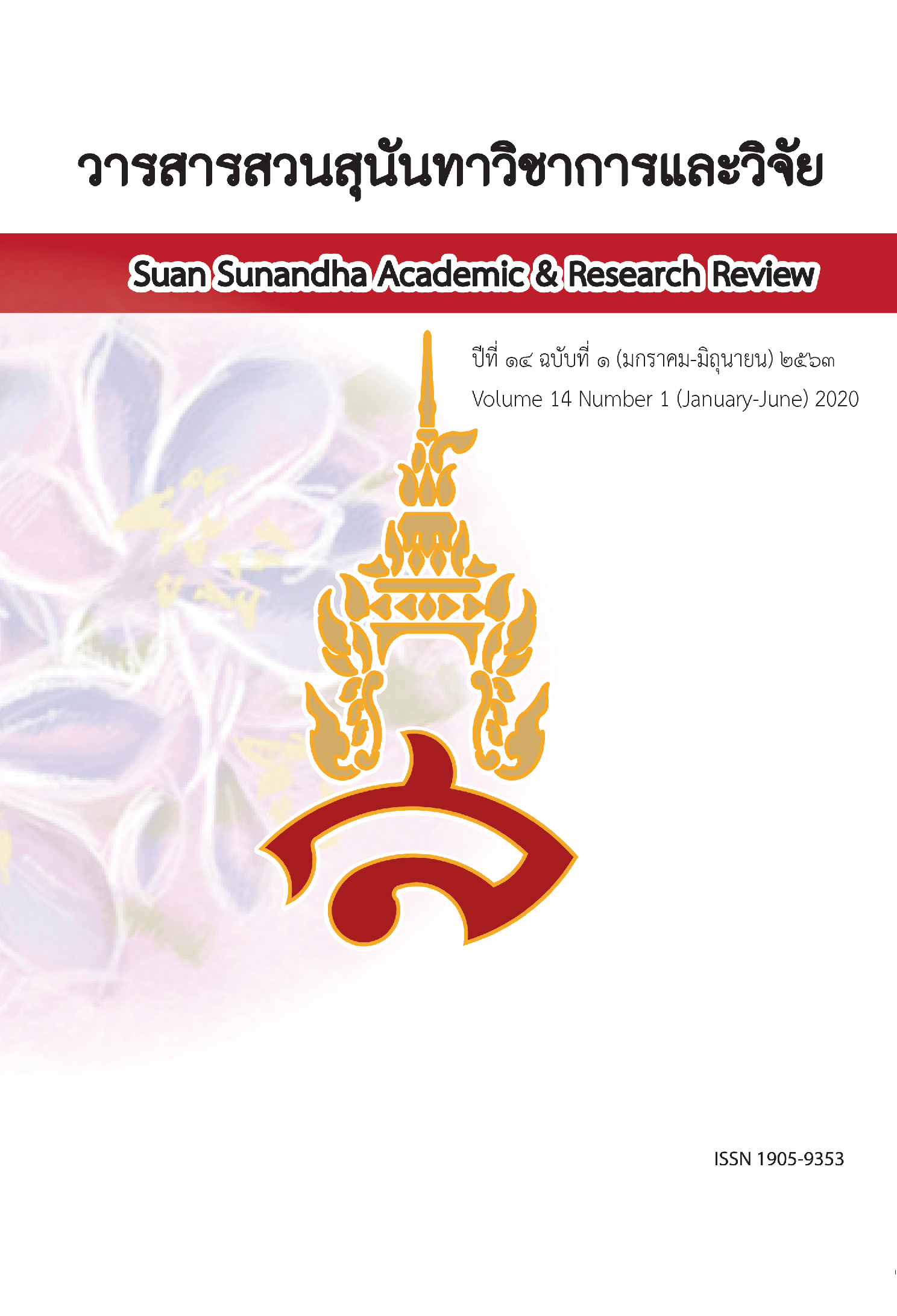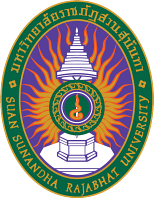The Semantic Field of Technical Terms in Mathematics and Sciences for the 7th Grade English Program in Thailand
คำสำคัญ:
Semantic field, Technical terms, Mathematics and Sciences, English programบทคัดย่อ
The aims of this study are 1) to analyze the semantic field of technical terms in Mathematics and Sciences in the relation of hyponymy; 2) to create the MS Word Net on the smartphone application for Thai grade 7 English program students; and 3) to evaluate the MS Word Net on the smartphone application. The research procedures consist of analyzing the semantic features of the technical terms by using Componential Analysis and classifying the technical terms based on the Semantic Field Theory in the relation of hyponymy.
The results revealed that the semantic field of mathematics technical terms was divided into eight main groups: Arithmetic, Algebra, Geometry, Statistics, binary operation, property rule, Mathematical symbol, and variable. The semantic field of Sciences technical terms was divided into four main groups: Chemistry, Physics, Earth Science, and Biology. Each group was further divided into several subgroups. According to the semantic feature analysis, the technical terms that had common semantic features were classified under the same concept to form a semantic field (Ullmann, 1977). Furthermore, the technical terms’ meanings in the same sematic field were related and they had at least one different semantic feature. Consequently, the analysis of the technical terms’ meanings by Componential Analysis assisted to classify them into the semantic fields.
The findings of the evaluation of the MS Word Net on the smartphone application usage revealed that the items with highest average were the “systematic data linking” on the MS Word Net application and the “benefits on the learners” of the MS Word Net ( = 4.54, S.D. = 0.62), followed by the “appropriate graphics” on the MS Word Net application ( = 4.53, S.D. = 0.74) and the “increases in the learners’ memory of the technical terms” using the MS Word Net ( = 4.48, S.D. = 0.62).
เอกสารอ้างอิง
of Reading Technical Report No. 136.
Bright, J.A. & McGregor, G.P. (1970). Teaching English as a Second Language: Theory and Techniques for the
Secondary Stage. London: Longman.
Carter, R. (1987). Vocabulary: Applied Linguistics Perspectives. London: Allen & Unwin.
Collins COBUILD Advanced Dictionary (1987).Glasgow:HarperCollins Publishers.Retrieved June,2019, from https://www.collinsdi ctionary.com/dictionary /english/
Gao, C. and Xu, B. (2013). The Application of Semantic Field Theory to English Vocabulary Learning. Journal of
Theory and Practice in Language Studies, 3(11), 2030-2035.
Glossary of Mathematical Terms &Definition, from https://www.storyofmathematics.com/glossary.html
Guo, C. (2010). The Application of the Semantic Field Theory in College EnglishVocabulary Instruction. Chinese
Journal of Applied Linguistics (Bimonthly), 33(3), 50-62.
Gutiérrez Rodilla. B.M. (1998). La cienciaempieza en la palabra. Capellades, Ediciones Peninsula, S.A. Jane B. Reece, Lisa A. Urry, Michael L. Cain, Steven A. Wasserman, Peter V. Minorsky,
Robert B. Jackson. (2013). Campbell Biology. United State: Pearson Education.
Laten, S. and Chadcham, S. (2017). Mobile Applications Design Based on Bloom’s Revised Taxonomy. Research
Methodology & Cognitive Science, 15(2), 1-11.
Lexitron Thai –English Electronic Dictionary.2009). Bangkok: National Science and Technology Development Agency. Retrieved January, 2019, from https://lexitron.nectec.or.th/2009_1/
Lyons, J. (1995). Linguistic semantics: An introduction. Cambridge, England: Cambridge University Press
Mathematic Encyclopedia. (2019). Oxford: Oxford University Press. Retrieved June, 2019, from
https://www.encyclopedia.com/science-and-technology/mathematics/
Mathematic Encyclopedia. (2019). Oxford : Oxford University Press. Retrieved June, 2019, from
https://www.encyclopedia.com/science- and-technology/mathematics/.
Mezynski, K. (1983). Issue Concerning the Acquisition of Knowledge: Effects of Vocabulary Training on Reading
Comprehension. SAGE Journal, June 1.
Ministryof Education. (2017). Basic Education Core Curriculum B.E. 2551 (The newly revised curriculum of
B.E.2560 (A.D.2017). Bangkok.
Newmark, P. (1995). Approaches to translation. Hempstead [UK]: Phoenix ELT.
Nida, E. A. (1975). Componential Analysis of Meaning. The Hague: Mouton.
Office of the Basic Education Commission. (2005). English Program. Ministry of Education. Bangkok.
Oxford Dictionary of Biology. (2014). Oxford: Oxford University Press. Retrieved July, 2019, from https://www.oxfordreference.com/view/10.1093/acref/9780199204625.001.0001/acref- 9780199204625
Oxford Dictionary of Chemistry. (2008). Oxford: Oxford University Press. Retrieved July, 2019, fromhttps://www.oxfordreference.com/view/10.1093/acref/9780199204632.001.0001/acref-
9780199204632
Oxford, R. & Crookall, D. (1990). Vocabulary Learning: Critical Analysis of Techniques. TESL Canada Journal/Revue
TESL Du Canada, 7, 9-30.
Palmer,F.R. (1976). Semantics: A new Outline. Cambridge: Cambridge University Press.
Pimporn Wattanakamolkul. (2019). The Study of Potentials for Learning Chinese Vocabulary and Chinese
Language Proficiency of Chinese Major Students at Rajamangala University of Technology Rattanakosin.
Suan Sunandha Academic & Research Review, 13, 2 (July – December).
Quan, D.D. (2002). Investigating the Relationship between Vocabulary Knowledge and Academic Reading
Performance: An Assessment Perspective. Language Learning, 52(3), 513-536.
Saeed, J I. (2009). Semantics. 3rd ed. United Kingdom: Wiley Blackwell.
Science and Technology Encyclopedia. (2019). Oxford: Oxford University Press. Retrieved July, 2019, from
https://www.encyclopedia.com/science- and-technology/mathematics/
Szynalski, Tomasz P. (1987). Review of the Collins COBUILD Advanced Learner's English Dictionary.
Antimoon.com. Retrieved 1 February 2011.
Terminology. (2019). Bangkok: Office of the Royal Society.Retrieved January, 2019, from http://www.royin.go.th/coined_word/
Thai word repository. (2009). Bangkok: The Institute for the Promotion of Teaching Science and Technology.
Retrieved January, 2019, from http://www.thaiglossary.com/groups/ipst-vocab/browse/published/
Trier, J. (1934). Das Sprachliche Feld. EineAuseinandersetzung.NeveJahrbucher fur Wissenschaft und Jungenbildung, 10, 428-449
Ullmann, S. (1977). Semantics: An Introduction to the Science of Meaning. Oxford: Basil Blackwell.
Wangru, C. (2016). Vocabulary Teaching based on Sematic-Field. Journal of Education and Learning, 5 (3), 64-71.
Zhou, Weijie. (1997). A Research on English Semantic Field. Shandong Foreign Language Journal, 68, 21-23
ดาวน์โหลด
เผยแพร่แล้ว
รูปแบบการอ้างอิง
ฉบับ
ประเภทบทความ
สัญญาอนุญาต

อนุญาตภายใต้เงื่อนไข Creative Commons Attribution-NonCommercial-NoDerivatives 4.0 International License.
บทความที่ได้รับการตีพิมพ์เป็นลิขสิทธิ์ของ สถาบันวิจัยและพัฒนา มหาวิทยาลัยราชภัฎสวนสุนันทา
ข้อความที่ปรากฏในบทความแต่ละเรื่องในวารสารวิชาการเล่มนี้เป็นความคิดเห็นส่วนตัวของผู้เขียนแต่ละท่านไม่เกี่ยวข้องกับมหาวิทยาลัยราชภัฎสวนสุนันทา และคณาจารย์ท่านอื่นๆในมหาวิทยาลัยฯ แต่อย่างใด ความรับผิดชอบองค์ประกอบทั้งหมดของบทความแต่ละเรื่องเป็นของผู้เขียนแต่ละท่าน หากมีความผิดพลาดใดๆ ผู้เขียนแต่ละท่านจะรับผิดชอบบทความของตนเองแต่ผู้เดียว






